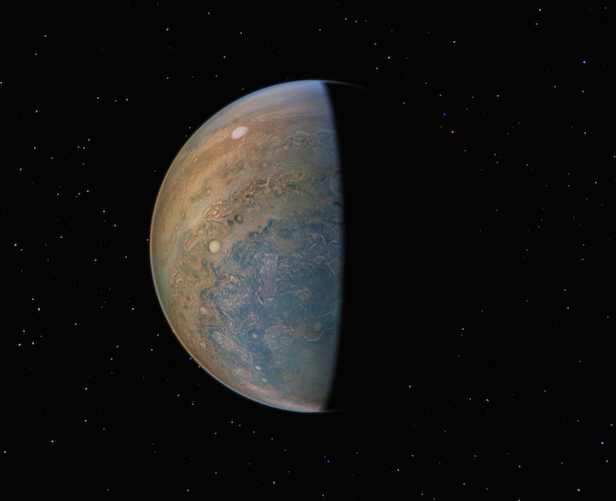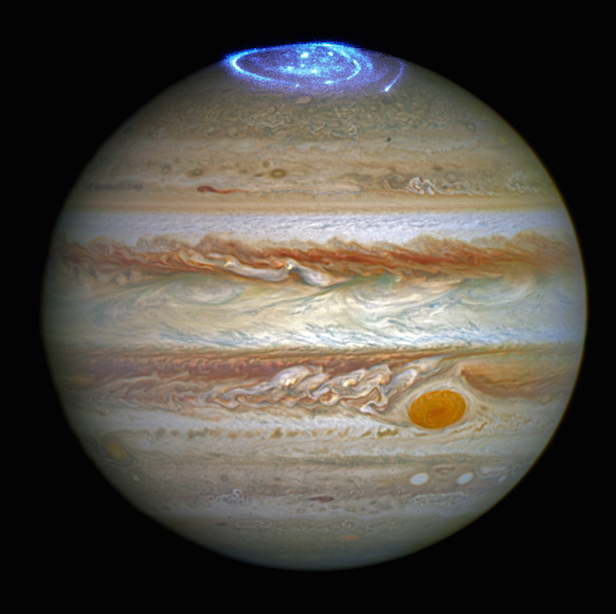Juno Update: Latest results at Jupiter baffle astronomers
After almost a year of observing the gas giant, fascinating and complicated findings have been uncovered

This JunoCam image was processed by citizen scientist Bruce Lemons, showing the rarely-seen pole of Jupiter with a bluish colour. Image credit: NASA/SwRI
On 5 June 2017, it will be a year since the Juno spacecraft arrived at Jupiter, and NASA has released the early and long-awaited results of the mission. The outcome shows a colossal, complex, captivating planet that is making us rethink everything we know about king of the Solar System.
The Juno spacecraft is equipped with eight scientific instruments, designed to probe the magnetosphere, atmosphere and interior structure. The data has challenged us to rethink all three of these areas. Before Juno arrived at Jupiter, the magnetometer investigation (MAG) was already measuring the magnetic field of the Jovian giant as it interacts with solar winds. But since then, it has mapped the magnetic field must closer to the surface, and it appears substantially greater than our models suggest. Not only that, but the magnetic field strength is unevenly distributed, meaning it is stronger in some areas rather than others. This uneven magnetic field could be explained by a dynamo effect, which is thought to be a region towards the surface. This region of rotating, convecting and electrically conducting fluid not only creates such a strong magnetic field, which causes such variation in the strength.
The aurora has also been an area of intense study, using the Jovian Auroral Distributions Experiment (JADE). It was previously thought that aurorae on Jupiter occurred when the electricity within the atmosphere excites the molecules at the poles. As it turns out, it is much different as Dr. Jonathan Nichols, Reader in Planetary Aurorae at University of Leicester explains: “Jupiter threw an auroral firework party to celebrate Juno’s arrival. We have been able to show that intense pulses of aurora were triggered during intervals when the solar wind was buffeting the giant magnetosphere. This tells us that even Jupiter’s mighty magnetosphere is, like those of Earth and Saturn, not immune to the vagaries of the Sun and the solar wind.”

This image combines an image taken with Hubble Space Telescope in the optical (taken in spring 2014) and observations of its auroras in the ultraviolet, taken in 2016. Image credit: NASA/ESA & J. Nichols (University of Leicester)
Images taken by the JunoCam have been public access for the duration of this mission, and this has resulted in some remarkable displays. These images show areas of Jupiter previous unseen, such as the poles, which seem to have a series of cyclones appearing – some up to the size of Mars. These cyclones pose a number of questions, such as: are these temporary or permanent? What is causing them to appear? Is this a stable system? It’s currently understood that cyclones don’t appear symmetrically, posing more questions then answers. However, what is clear is that there is an unusual environment beneath the clouds, yet to be understood.
Juno’s Microwave Radiometer (MWR) has gathered data of Jupiter in the attempt to understand what is happening on the gas giant’s surface. When the belts, or ‘rings’, were observed, it became clear after analysis that they’re unlevel. The belt near the equator pierces through the surface as far as the MWR can see. With the other belts though, they don’t pierce as far down, and actually vary in distance. This could be a sign that the ammonia levels differ with each ring, which yet again makes the mystery of Jupiter’s atmosphere baffle astronomers worldwide.
More orbits are still yet to come, and eventually it will meet its demise when it burns up reaching the closest approach to Jupiter’s atmosphere in February 2018. With such head-scratching, mind-boggling results so far, it is fair to say astronomers can’t wait to get their hands on even more of Juno’s data.
Keep up to date with the latest space news in All About Space – available every month for just £4.99. Alternatively you can subscribe here for a fraction of the price!




